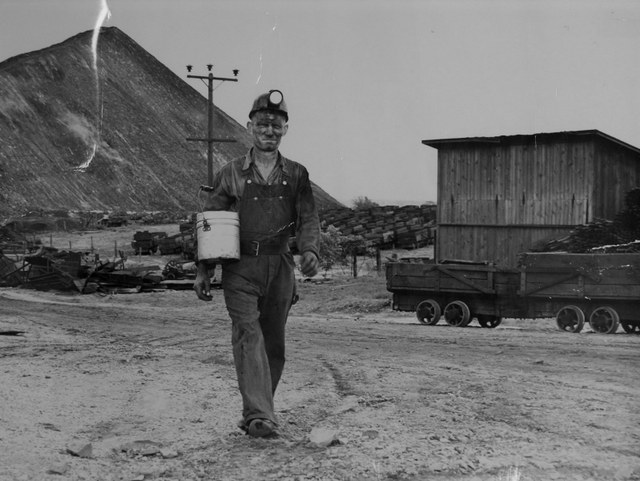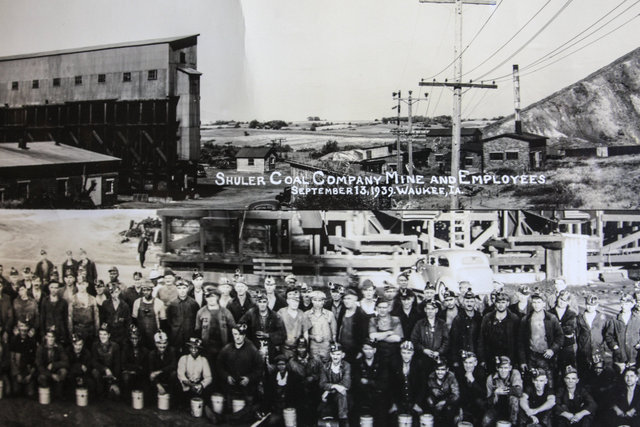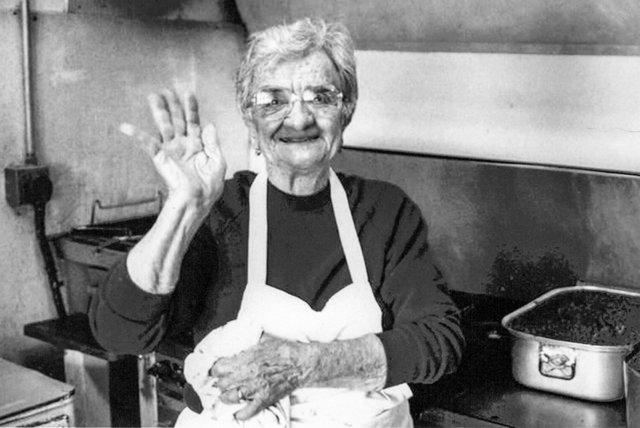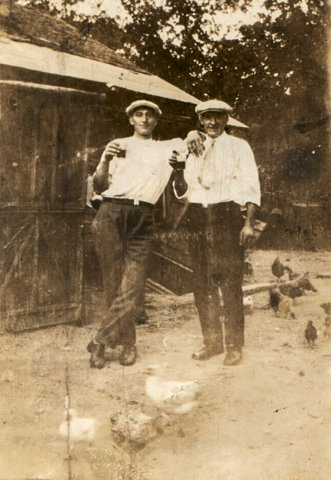
Iowa Underground – How Coal Mining Fueled Dallas County’s Growth
There was a time when Dallas County was one of the most important coal-mining counties in Iowa. While this way of life vanished decades ago, the memories live on, from rooms at the historic Hotel Pattee in Perry to the coal-mining museum in the Waukee Public Library to the many descendants of mining families who still live in the area.
From Moran to Woodward to Waukee, Dallas County thrived with the increased demand a century ago for coal to power train locomotives and heat businesses and homes. Coal was a relatively cheap, plentiful energy source. With ample supplies of coal, Dallas County became a land of opportunity for immigrant miners from Europe and beyond.
Coal mining started in the Van Meter area as early as the 1870s. By the early 1900s, coal was discovered in Des Moines Township east of Woodward, leading to the creation of the Scandia and Phildia mining settlements. After the Phildia mine was abandoned in 1915 and the Scandia mine closed in 1921, miners moved on to the Moran mine, which opened in 1917 west of Woodward.
It’s not on most maps today, but there was a time when Moran was a bit of a boom town.Another mining town–Angus–was an even bigger boom town north of Perry. The Angus & Moran Room at the Hotel Pattee in Perry recalls the history of these areas, which are now little more than ghost towns.

Shuler Coal Mine and employees shown here on September 13, 1939, in Waukee, Iowa. The mine was open from 1921 to 1949. Source: Waukee Area Historical Society
Living with danger
On the opposite side of Dallas County, coal mining also transformed the Waukee area in the early twentieth century. The Harris Mine opened on September 20, 1920, just two and a half miles northeast of Hickman Road in Waukee.
By 1921, the Shuler Coal Company of Davenport, Iowa opened a coal mine on Alice’s Road, one mile east of the Harris Mine. At its peak production, the mine employed more than 450 men.
The Shuler Mine became one of the largest producers of coal in Iowa, and it had one of the deepest mine shafts–387 feet deep. The mine produced coal for Iowa State University, as well as for local railroads, businesses and homes.
The miners worked in the Shuler mine with the help of more than 30 mules, bringing up hundreds of tons of coal per day and millions of tons of coal over the mine’s 28 years of operation. The miners’ work day often started at 6 a.m., and they wouldn’t return home until 4 or 4:30 p.m.
Mining was dangerous, dirty work. Miners used dynamite, as well as heavy picks, to break coal loose from the coal veins. When the siren blew, it was a sign that a miner was in trouble, or there had been a cave-in.
“I can remember the whistle blowing in succession to let people know there had been an accident,” noted Angelo Stefani, whose uncle was killed in a mining accident. “I can also vividly member women coming out of their homes to see what happened. They were hysterical.”

Alice Nizzi was the founder and owner of the beloved Alice’s Spaghettiland, an Italian restaurant open from 1947 – 2004 in the Waukee area. Source: Waukee Area Historical Society
Life in Waukee’s coal mining community
The Shuler mining camp was home to Italians, Croatians and people of other ethnicities. Most families lived in small, simple houses with no running water, but they often raised chickens and tended enormous gardens where they grew a variety of vegetables.
Work wasn’t always steady. Dallas County’s coal mines often closed in the summer, when demand for coal dropped off in the warmer months. Miners would often work for local farmers or do odd jobs around the community to help pay the bills.
Some of the miners’ wives, especially those in Italian families, worked at local restaurants like Rosie’s and Alice’s Spaghettiland near Waukee to supplement the family’s income. Alice Nizzi (1905–1997) opened Alice’s Spaghettiland in the Shuler mining community just north of Hickman Road in 1947. The restaurant’s waitresses were required to wear white, starched uniforms. Alice’s became a destination and Waukee-area institution for decades until it closed in 2004.
The Waukee Area Historical Society hosted a fundraising dinner in the spring of 2014 featuring Alice’s spaghetti and Italian salad. Hundreds of people now attend this fun event, which has been held each April for the past few years.

Terzo Fiori (left) and Pete Nizzi enjoyed tasting their homemade wine. Excitement spread through Waukee’s mining camps when grapes were imported from California and shipped by train in two boxcars so families could make their yearly supply of red wine.
Remembering the grape trains
For Italian families in the Shuler mining camp, one of the highlights of the year was the arrival of the annual trainload of grapes for making homemade wine.
“Excitement spread throughout the camp when the train arrived, and most of the people from the mining camp came to help unload the box cars,” said Gilbert Andreini, whose memories are recorded at the coal mining museum at the Waukee Public Library. “It was like a celebration.”
The end of an era
By the time the Shuler mine closed in 1949, Iowans began looking to energy sources other than coal for home use, such as electricity, natural gas and heating oil. In addition, the railroads were converting from steam to diesel engines, reducing the need of coal for locomotives.
While Dallas County’s coal mines have vanished into history, those who grew up in the mining camps will never forget how these areas grew into close-knit communities. Everyone knew everyone else and helped each other out, recalled Bruno Andreini.
“I’m very proud of those times. Anyone from that community is like a brother or sister to me. Even though we were poor, we had things that were far more valuable than money.”
Note from Hometown Heritage
I originally wrote this as a guest blog post for Hometown Heritage in Perry. Here’s a note from Hometown Heritage:
If you’d like to meet Darcy, hear more of her stories, and enjoy some Dallas County-inspired snacks, Darcy will be speaking at Hotel Pattee on September 11th, 2017, from 7 – 9 pm as part of Hometown Heritage’s fall programming series. For more information on this, please visit our website.
You can also learn more about Darcy on her website (www.darcymaulsby.com), and her new Dallas County book is available for pre-order on Amazon.
Want more?
Thanks for stopping by. I invite you to read more of my blog posts if you want more more intriguing Iowa stories and history, along with Iowa food, recipes and tips to make you a better communicator. If you like what you see and want to be notified when I post new stories, be sure to click on the “subscribe to blog updates/newsletter” button at the top of this page. Feel free to share this information with friends and colleagues who might be interested, too.
If you’re hungry for more stories of Iowa history, check out my top-selling “Culinary History of Iowa: Sweet Corn, Pork Tenderloins, Maid-Rites and More” book from The History Press, as well as my Calhoun County” book from Arcadia Publishing, which showcases the history of small-town and rural Iowa. Order your signed copies today! Iowa postcards are available in my online store, too.
Let’s stay in touch. I’m at darcy@darcymaulsby.com, and yettergirl@yahoo.com.
P.S. Thanks for joining me. I’m glad you’re here.
@Copyright 2017 Darcy Maulsby & Co.
About me:
Some people know me as Darcy Dougherty Maulsby, while others call me Yettergirl. I grew up on a Century Farm between Lake City and Yetter and am proud to call Calhoun County, Iowa, home. I’m an author, writer, marketer, business owner and entrepreneur who specializes in agriculture. Learn more at www.darcymaulsby.com.
2 responses to “Iowa Underground – How Coal Mining Fueled Dallas County’s Growth”
Recent Posts
- Do Press Releases Still Work?
- Erasing History? Budget Cuts Threaten to Gut Ag History at Iowa State University
- Machines that Changed America: John Froelich Invents the First Tractor in Iowa
- Bob Feller on Farming, Baseball and Military Service
- Classic Restaurants of Des Moines: A Taste of Thailand Served the "Publics" and Politics
- Want to Combat Fake News? Become a Better Researcher
Categories
- Achitecture
- Agriculture
- Architecture
- baking
- barbeque
- Barn
- breakfast
- Business
- Communication Tips
- Conservation
- content
- cooking
- Crime
- Dallas County
- Economical
- Farm
- Featured
- Food
- Food history
- health
- Iowa
- Iowa food
- Iowa history
- marketing
- Photography
- Recipes
- Seasonal
- Small town
- Storytelling
- Uncategorized
- writing
Archive by year
- 2023
- 2022
- 2021
- 2020
- When Agriculture Entered the Long Depression in the Early 1920s
- The Corn Lady: Jessie Field Shambaugh and the Birth of 4-H in Iowa
- Sauce to Sanitizer: Cookies Food Products Bottles Hand Sanitizer Made with Ethanol
- Myth Busting: No, Your Pork Doesn't Come from China
- Long Live Print Newsletters! 5 Keys to Content Marketing Success
- Shattering Silence: Farmer Helped Slave Find Freedom and Racial Equality in Iowa
- Meet Iowa Farmer James Jordan, Underground Railroad Conductor
- George Washington Carver Rose from Slavery to Ag Scientist
- Remembering the African-American Sioux City Ghosts Fast-Pitch Softball Team
- Want to Combat Fake News? Become a Better Researcher
- Classic Restaurants of Des Moines: A Taste of Thailand Served the "Publics" and Politics
- 2019
- The Untold Story of Iowa’s Ag Drainage Systems
- Stop Rumors Before They Ruin Your Brand
- Finding Your Voice: The Story You Never Knew About "I Have a Dream"
- Warm Up with Homemade Macaroni and Cheese Soup
- Can a True Story Well Told Turn You into a Tom Brady Fan?
- Baking is for Sharing: Best Bread, Grandma Ruby’s Cookies and Other Iowa Favorites
- 4 Key Lessons from Bud Light’s Super Bowl Corn-troversy
- Could Your Story Change Someone’s Life?
- What To Do When the Travel Channel Calls
- Tex-Mex Sloppy Joes and the Magic of Maid-Rite in Iowa
- How Not to Invite Someone to Your Next Event--and 3 Solutions
- We Need FFA: Iowa Ag Secretary Mike Naig Reflects on His FFA Experiences
- From My Kitchen to Yours: Comfort Food, Conversation and Living History Farms
- Smart Marketing Lessons from an Uber Driver--Listen Up!
- Hog Trailers to Humidors: Two New Iowa Convenience Stores Reflect “Waspy’s Way”
- A Dirty Tip to Make Your Social Media Content More Shareable
- Are You on Team Cinnamon Roll?
- Senator Grassley on Farming: Any Society is Only Nine Meals Away From a Revolution
- Why We Should Never Stop Asking Why
- What’s the Scoop? Expanded Wells’ Ice Cream Parlor Offers a Taste of Iowa
- Independence, Iowa’s Connection to the Titanic and Carpathia
- Memories of Carroll County, Iowa, Century Farm Endure
- Iowa's “Peacemaker Pig” Floyd of Rosedale Helped Calm Racial Tensions
- 2018
- How to Cook a Perfect Prime Rib
- How Did We Get So Rude?
- Mmm, Mmm Good: Soup’s on at the Rockwell City Fire Department
- Quit Using “Stupid Language”
- In Praise of Ham and Bean Soup
- Recalling a Most Unconventional—and Life-Changing--FFA Journey
- Events Spark Stories That Help Backcountry Winery Grow in Iowa
- Sac County Barn Quilt Attracts National Attention
- Doing Good, Eating Good at Lytton Town Night
- Young Entrepreneur Grows a Healthy Business in Small-Town Iowa
- Digging Deeper: Volunteers Showcase Thomas Jefferson Gardens in Iowa
- How to Tell Your Community’s Story—with Style!
- DNA Helps Sailor Killed at Pearl Harbor Return to His Family
- It’s Time to Be 20 Again: Take a Road Trip on Historic Highway 20
- The Biggest Reason You Shouldn’t Slash Your Marketing Budget in Tough Times
- Are You Telling a Horror Story of Your Business?
- Pieced Together: Barn Quilt Documentary Features Iowa Stories
- Unwrapping Storytelling Tips from the Candy Bomber
- Barn Helped Inspire Master Craftsman to Create Dobson Pipe Organ Builders
- Butter Sculptures to Christmas Ornaments: Waterloo Boy Tractor Celebrates 100 Years
- Ag-Vocating Worldwide: Top 10 Tips for Sharing Ag’s Story with Consumers
- 2017
- Growing with Grow: Iowa 4-H Leader Guides 100-Year-Old 4-H Club for 50 Years
- High-Octane Achiever: Ethanol Fuels New Driver Tiffany Poen
- Shakespeare Club Maintains 123 Years of Good Taste in Small-Town Iowa
- Iowa’s Ice Queen: Entrepreneur Caroline Fischer’s Legacy Endures at Hotel Julien Dubuque
- Darcy's Bill of Assertive Rights: How to Communicate and Get What You Need
- Celebrating Pi Day in Iowa with Old-Fashioned Chicken Pot Pie
- Cooking with Iowa’s Radio Homemakers
- Top 10 Tips to Find the Right Writer to Tell Your Company’s Stories
- The “No BS” Way to Protect Yourself from Rude, Obnoxious People
- Learning from the Land: 9 Surprising Ways Farmers Make Conservation a Priority
- Leftover Ham? Make This Amazing Crustless Spinach and Ham Quiche
- Iowa’s Lost History from the Titanic
- Coming Soon--"Dallas County," a New Iowa History Book!
- How to Clean a Burned Pan in 6 Simple Steps
- Iowa Beef Booster: Larry Irwin Takes a New Twist on Burgers
- Get Your Grill On: How to Build a Better Burger
- "Thank God It’s Over:" Iowa Veteran Recalls the Final Days of World War 2
- How to Thank Veterans for Their Military Service
- Imagine That! Writers, Put Your Reader Right in the Action
- Remembering Ambassador Branstad’s Legacy from the 1980s Farm Crisis in Iowa
- Busting the Iowa Butter Gang
- Lightner on Leadership: “Everyone Has Something to Give”
- Show Up, Speak Up, Don’t Give Up
- Small - Town Iowa Polo Teams Thrilled Depression - Era Crowd
- Ethanol:Passion by the Gallon
- Cruising Through Forgotten Iowa History on Lincoln Highway
- Why I'm Using a Powerful 500-Year-Old Technology to Make History--And You Can, Too
- 5 Ways a “History Head” Mindset Helps You Think Big
- Behind the Scene at Iowa's Own Market to Market
- Let’s Have an Iowa Potluck with a Side of History!
- Iconic State Fair Architecture: Historic Buildings Reflect Decades of Memories
- Iconic State Fair Architecture- Historic Buildings Reflect Decades of Memories
- Iowa Underground - How Coal Mining Fueled Dallas County's Growth
- Ultra-Local Eating: Jennifer Miller Guides CSA, Iowa Food Cooperative
- The Hotel Pattee and I are Hosting a Party—And You’re Invited!
- Tell Your Story—But How?
- Mediterranean Delights: Iowa Ag Influences Syrian-Lebanese Church Dinner
- 6 Steps for More Effective and Less Confrontational Conversations
- 6 Steps for More Effective and Less Confrontational Conversations!
- 6 Ways to Motivate Yourself to Write—Even When You’re Not in the Mood
- Always Alert-How to Stay Safe in Any Situation
- Does Accuracy Even Matter Anymore?
- Soy Power Shines at Historic Rainbow Bridge
- Free Gifts! (Let’s Talk Listening, Stories and History)
- 2016
- How to Connect with Anyone: Lessons from a Tornado
- Soul Food: Lenten Luncheons Carry on 45-Year Iowa Tradition
- Top 3 Tips for Writing a Must-Read Article
- Darcy's Top 10 Tips to Better Writing
- Top 8 Tips for Building a Successful Freelance Business
- 10 Steps to Better Photos
- Reinventing the Marketer of 2010
- Extreme Writing Makeover
- My Top Social Media Tips for Farmers: REVEALED!
- Honoring the Legacy of Rural Iowa's Greatest Generation
- Iowa's Orphan Train Heritage
- Dedham’s Famous Bologna Turns 100: Kitt Family Offers a Taste of Iowa History
- Iowa Barn Honors Pioneer Stock Farm
- Darcy's Top 10 Tips for Better Photos
- Soup and Small-Town Iowa Spirit
- Savoring the Memories: Van's Café Served Up Comfort Food for Six Decades
- Mayday, Mayday—The Lost History of May Poles and May Baskets in Iowa
- Iowa's Vigilante Crime Fighters of the 1920s and 1930s
- Very Veggie: Iowan's Farm-Fresh Recipes Offer Guilt-Free Eating
- Iowa Public TV's "Market to Market" Features Expedition Yetter, Agri-Tourism, Des Moines Water Works' Lawsuit
- 62 Years and Counting: Calhoun County, Iowa, Families Maintain 4th of July Picnic Tradition
- “A Culinary History of Iowa” Satisfies: Iowa History Journal Book Review
- For the Love of Baking: Lake City's Ellis Family Showcases Favorite Iowa Farm Recipes (Caramel Rolls, Pumpkin Bars and More!)
- Remembering Sept. 11: Iowa Community’s Potluck Honors America
- Talking Iowa Food and Culinary History on Iowa Public Radio
- Talking "Stilettos in the Cornfield," Taxes, Trade and More on CNBC
- FarmHer #RootedinAg Spotlight--FFA Attracts More Women to Careers in Ag
- Rustic Cooking Refined: Iowan Robin Qualy Embraces Global Flavors
- Voice of Reason: Iowa Pork Producer Dave Struthers Offers Top 10 Tips to Speak Up for Ag
- Iowa Eats! Why Radio Iowa, Newspapers and Libraries are Hungry for "A Culinary History of Iowa"
- Iowa Turkeys Carry on National Thanksgiving Tradition
- Riding with Harry: 2016 Presidential Election Reflects Truman's Iowa Revival at 1948 Plowing Match in Dexter
- All Aboard! Rockwell City’s “Depot People” Offer a Taste of Iowa History
- Is This Iowa's Favorite Appetizer?
- O, Christmas Tree! Small Iowa Towns Celebrate with Trees in the Middle of the Street
- Slaves Escaped Through Dallas County on Iowa’s Underground Railroad
- Adel Barn Accents Penoach Winery in Iowa
- Celebrating New Year's Eve in Style at a Classic Iowa Ballroom

I remember eating at the famous Alice’s Spaghettiland with a date in the early 1960s. (Dad only liked Mom’s spaghetti.) Sure didn’t know about all the coal mine history in Dallas County.
Hi, I am looking for a photograph of my wife’s great grandfather William Walker. He was a coal miner in Dallas County for 20 years. He actually died at the age of 93 at the Waukee Coal Camp of Bronchial Pneumonia. He was born Nov 7 1835 and died Mar 16, 1929 and is buried in Woodward, IA. I understand that they called him William “Pegleg” Walker due to his wooden leg. Any help or direction that you can give me is much appreciated.
Thanks
Steve